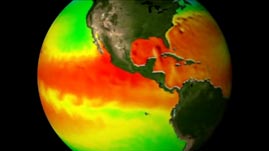Teachers' Domain - Digital Media for the Classroom and Professional Development
User: Preview

Source: A Navajo Technical College production for NASA's Where Words Touch the Earth



In this video segment adapted from Navajo Technical College, learn about the relationship between carbon dioxide emissions and climate change. Meet Patricia Palmer, a chemistry professor, who explains that coal power plants (such as those found on and around the Navajo Nation) contribute to increasing levels of carbon dioxide in the atmosphere. See a visual representation of how global surface temperatures have increased during the 20th century. In addition, learn how people can use less energy to help reduce their carbon footprint and mitigate the effects of climate change.
Fossil fuels—such as coal, oil, and natural gas—have served as a primary source of energy for human activities worldwide. We burn fossil fuels to generate electricity, provide heat, and power our cars, trains, planes, and other vehicles. The combustion of fossil fuels supplies energy, but it also produces greenhouse gases.
Greenhouse gases (such as carbon dioxide, water vapor, methane, and nitrous oxide) trap energy and produce the greenhouse effect, a natural process that keeps Earth warm and habitable. However, human activity has greatly increased the concentration of greenhouse gases in the atmosphere, creating a more severe greenhouse effect. At the same time, Earth's average surface temperature has been increasing. Scientific records show that the average global temperature has warmed by about 1.5°F (about 1°C) since 1880. This seemingly small change can have dramatic effects on ecosystems and climates around the world. Most scientists agree that humans have contributed to the warming trend. In particular, human activities (such as burning fossil fuels and deforestation) increase the concentration of carbon dioxide in the atmosphere.
Coal-burning power stations are a major source of carbon dioxide. They also produce other pollutants, including sulfur dioxide, nitrogen oxides, and particulate matter. These air pollutants react with the atmosphere to produce acid rain, which can have negative impacts on ecosystems and can damage buildings and other structures. The pollution emitted by power stations also harms human health: high levels of air pollution can cause respiratory problems and heart disease. The communities that live closest to a power plant experience the greatest health impacts.
About half of all the electricity generated in the United States comes from burning coal. The Navajo Generating Station, which began operating in 1974 and is located on Navajo land, is the largest coal-fired plant in the western U.S. It was built as a source of electricity to power the pumping stations for the Central Arizona Project (CAP), a 336-mile (541-km) system designed to deliver water to millions of users. The power plant burns about 8 million tons of coal each year, which translates to about 20 million tons of carbon dioxide emissions annually.
Although fossil fuels currently supply most of the world's energy, there are alternative energy options available that can be less damaging to human health and the environment, such as solar, wind, or geothermal energy. As power stations age and environmental regulations change, older facilities need to be serviced, upgraded, and sometimes retired. The Navajo Generating Station is located in one of the country's best areas for solar power; however, development of a photovoltaic power station of comparable capacity is not likely because it would require hundreds of millions of square feet for the solar panels. Other possible alternatives include reducing coal consumption by supplementing it with solar power or providing onsite solar power directly at CAP pumps.
 Loading Standards
Loading Standards